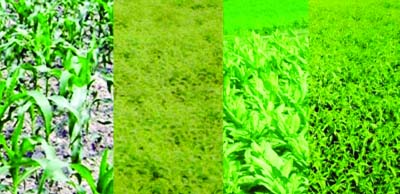
BSS, Rangpur :
The vast tracts of the dried-up riverbeds and char areas have now worn greenish eye-catching looks as the Rabi crops are growing excellent everywhere in the northern districts along the Brahmaputra basin.
Like in the previous years, hundreds of landless people and char dwellers have cultivated various crops on these char lands and dry-up beds of the Brahmaputra, Teesta, Dharla, Ghaghot, Jamuna and other rivers in the northern district this season.
According to sources in the Department of Agriculture Extension (DAE) and different NGOs, cultivation of crops has been increasing on the char lands and dried-up riverbeds as well as their tributaries in the northern districts in recent years.
During the current Rabi season, more than 78,000 hectares of land have been brought under crop cultivation on the dried-up beds of the Brahmaputra, Teesta, Dharla, Ghaghot and Jamuna, other rivers, tributaries and char areas in the northern districts.
Sowing of drop seed has already been completed and seedling transplantation of early variety Boro rice still continues while the tender crop plants have been growing superbly creating enthusiasm among the char dwellers, riverside people and farmers.
Meanwhile, char people are expected to begin harvest of mustard seed by middle of January next though harvest of the other crops on dried-up riverbeds and char lands will be completed before commencement of the next rainy season.
Talking to BSS, char people Solaiman Ali, Ahsan Habib, Kafil Uddin, Sunil Kumar, Shefali Begum and Kohinoor Khatun said they have cultivated crops on the dried- up riverbeds and char lands this season to harvest those mostly from February next.
They said that the Teesta, Dharla, Brahmaputra and other rivers have almost dried up now with lowest water flows in their channels, giving rise to hundreds of shoals on their beds hampering navigability.
It happens every year much ahead of the dry season enabling to grow crops on the dried-up riverbeds to earn livelihoods through adapting with the new mode of living and existence side by side with the ongoing huge climate change, they said.
Horticulture Specialist of the DAE Khondker Md. Mesbahul Islam said farmers have mostly cultivated mustard, wheat, maize, pulse, Boro, tobacco, vegetables, groundnut, pumpkin, ‘china’, ‘kawn’, pulses, ‘gunji till’, corn, watermelon and other crops this season.
He said abnormal drying up of the rivers and deposition of silts have been continuing alarmingly in recent decades due to climate change, lifting of underground waters and other manmade reasons paving the way for crop cultivation of the riverbeds.
Associate Director- Agriculture of BRAC International (South Asia and Africa) Dr M A Mazid said riverbed crop cultivation has become possible due to drying up of the rivers and abnormal rise of their beds as a result of massive silt deposition every year.
The vast tracts of the dried-up riverbeds and char areas have now worn greenish eye-catching looks as the Rabi crops are growing excellent everywhere in the northern districts along the Brahmaputra basin.
Like in the previous years, hundreds of landless people and char dwellers have cultivated various crops on these char lands and dry-up beds of the Brahmaputra, Teesta, Dharla, Ghaghot, Jamuna and other rivers in the northern district this season.
According to sources in the Department of Agriculture Extension (DAE) and different NGOs, cultivation of crops has been increasing on the char lands and dried-up riverbeds as well as their tributaries in the northern districts in recent years.
During the current Rabi season, more than 78,000 hectares of land have been brought under crop cultivation on the dried-up beds of the Brahmaputra, Teesta, Dharla, Ghaghot and Jamuna, other rivers, tributaries and char areas in the northern districts.
Sowing of drop seed has already been completed and seedling transplantation of early variety Boro rice still continues while the tender crop plants have been growing superbly creating enthusiasm among the char dwellers, riverside people and farmers.
Meanwhile, char people are expected to begin harvest of mustard seed by middle of January next though harvest of the other crops on dried-up riverbeds and char lands will be completed before commencement of the next rainy season.
Talking to BSS, char people Solaiman Ali, Ahsan Habib, Kafil Uddin, Sunil Kumar, Shefali Begum and Kohinoor Khatun said they have cultivated crops on the dried- up riverbeds and char lands this season to harvest those mostly from February next.
They said that the Teesta, Dharla, Brahmaputra and other rivers have almost dried up now with lowest water flows in their channels, giving rise to hundreds of shoals on their beds hampering navigability.
It happens every year much ahead of the dry season enabling to grow crops on the dried-up riverbeds to earn livelihoods through adapting with the new mode of living and existence side by side with the ongoing huge climate change, they said.
Horticulture Specialist of the DAE Khondker Md. Mesbahul Islam said farmers have mostly cultivated mustard, wheat, maize, pulse, Boro, tobacco, vegetables, groundnut, pumpkin, ‘china’, ‘kawn’, pulses, ‘gunji till’, corn, watermelon and other crops this season.
He said abnormal drying up of the rivers and deposition of silts have been continuing alarmingly in recent decades due to climate change, lifting of underground waters and other manmade reasons paving the way for crop cultivation of the riverbeds.
Associate Director- Agriculture of BRAC International (South Asia and Africa) Dr M A Mazid said riverbed crop cultivation has become possible due to drying up of the rivers and abnormal rise of their beds as a result of massive silt deposition every year.

